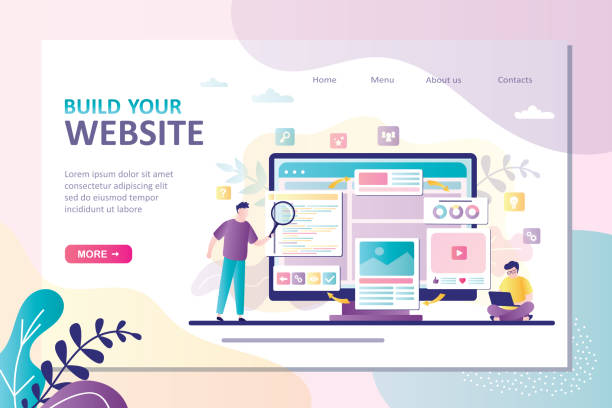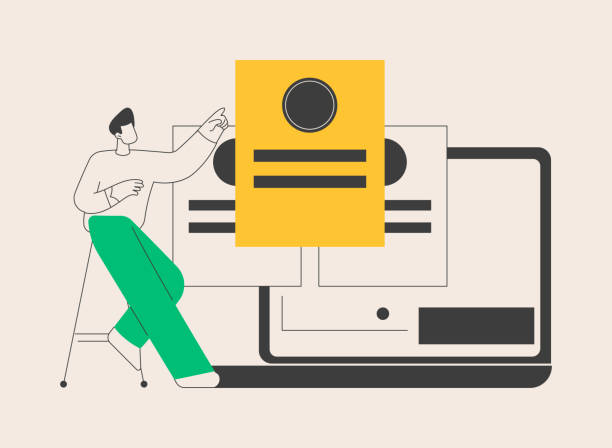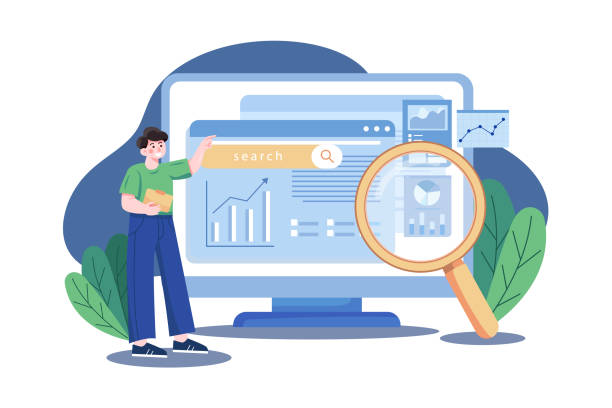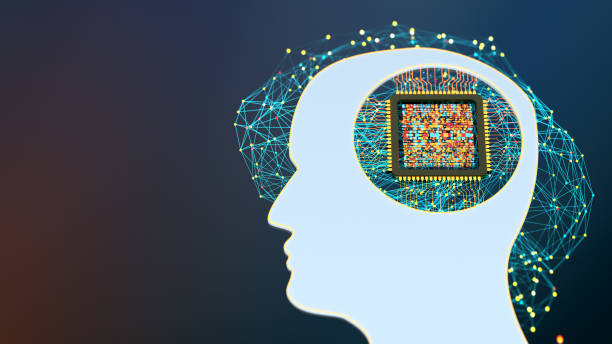Introduction to the Importance of Modern User Interface and User Experience

In today’s world, where digitalization has permeated all aspects of our lives, having a website is not merely about having an online presence.
Rather, how users interact with this presence plays a vital role in the success of a business.
This is where the concept of #Modern_UI_Website_Design and #User_Experience (UX) establishes itself as the cornerstone of effective communication with the audience.
The User Interface (UI) refers to all visual and interactive elements of a website; from buttons and forms to color schemes and fonts.
While User Experience is the user’s overall feeling when using that website.
A beautiful user interface without a smooth and functional user experience is like a luxury car without an engine.
The main goal in modern UI website design is to create a space where the user can easily achieve their goals, feel satisfied, and be willing to return.
This approach is not limited to visual aesthetics but also pays special attention to performance, speed, and ease of use.
This educational and explanatory section helps you gain a better understanding of these key concepts and their necessity in today’s competitive landscape.
By relying on modern design principles, one can not only improve user interaction but also increase conversion rates and ensure customer loyalty.
Are you tired of your e-commerce website not generating as much revenue as it could? Rasaweb, specializing in professional e-commerce website design, solves this problem forever!
✅ Increase sales rate and revenue
✅ High load speed and unparalleled user experience
⚡ Get free consultation for e-commerce website design
Key Principles in Modern User Interface Design

To achieve a modern UI website design that is both aesthetic and functional, a set of principles and rules must be adhered to.
The first principle is #simplicity and #clarity.
A good user interface should present information in a way that the user can access it without confusion and with minimal effort.
This means avoiding visual clutter and organizing content in a way that is appealing and understandable.
The second principle is #consistency in design.
Different elements and components of the website should maintain consistency across all pages; for example, Call-to-Action (CTA) buttons should always appear in a specific style and color.
This visual consistency helps the user become familiar with the website’s patterns and reach their desired content faster.
Usability or #Usability is also of high importance.
The website should be usable for all users, regardless of their level of digital literacy.
This includes providing appropriate feedback to the user after each action, such as displaying a success message after submitting a form or filling a progress bar in multi-stage processes.
Furthermore, attention to visual hierarchy to guide the user’s eye towards important information, and also creating appropriate spacing between elements (Whitespace) to prevent a cluttered feeling, are among the specialized tips in this field.
Adhering to these principles provides practical guidelines for designing an advanced and efficient user interface that will lead to a positive user experience and greater audience engagement.
Modern UI website design means creating a balance between aesthetics and functionality.
The Role of User Research and Usability Testing in Design

No modern UI website design is complete without a deep understanding of the user and their needs.
#User_Research is a fundamental step that helps us understand target audiences, their goals, pain points, and behaviors.
These researches can include interviews, surveys, focus groups, and analysis of existing data.
Using this information, we can create User Personas, which are fictional representations of our real users and help the design team consider user needs at every stage of design.
After the initial design, it’s time for #Usability_Testing.
These tests allow us to see how real users interact with the prototype or initial version of the website and what problems they encounter.
Problems that might remain hidden from designers are identified at this stage.
This analytical process gives us the opportunity to improve our design based on real user feedback.
For example, an A/B test can show which version of a button or a Landing Page performs better.
Finally, it’s an explanation that shows these steps not only help improve the user experience but also directly impact conversion rates and customer satisfaction.
Without this continuous research and testing, even the best visual designs may fail to meet the real needs of users.
Below is a table of user research methods:
| Method | Description | Research Type |
|---|---|---|
| User Interviews | Direct conversations to understand needs and motivations | Qualitative |
| Surveys | Collecting data from a large number of users to identify patterns | Quantitative |
| Usability Testing | Observing users performing tasks on the product | Qualitative |
| Competitor Analysis | Reviewing competitor websites to identify strengths and weaknesses | Qualitative/Quantitative |
Visual Aesthetics and Brand Identity in Modern Design

Visual aesthetics in modern UI website design goes beyond simply “being beautiful”; it is a powerful tool for communicating with the user and strengthening #Brand_Identity.
Every color, font, image, and even empty space (#Whitespace) on a website conveys a message.
Professional designers know well that choosing the right color palette should not only be attractive but also align with the brand’s personality and evoke specific emotions in the user.
For example, blue often conveys a sense of trust and stability, while red can evoke energy and urgency.
#Typography, or the selection and arrangement of fonts, also plays a key role in readability and aesthetics.
Fonts must be legible, but at the same time, reflect the brand’s style and personality.
Smart use of visual hierarchy with different font sizes, weights, and colors helps the user find important information faster.
This specialized section emphasizes that visual design should be engaging and attractive to encourage the user to stay and explore more on the site.
From high-quality images and appealing graphics to subtle animations, all can contribute to creating a pleasant visual experience.
The goal is for the website to not only be functional but also to convey a good feeling to the user and remain memorable in their mind.
A strong visual design can distinguish your brand among competitors and gain user trust and loyalty.
Did you know that a poor corporate website loses you many opportunities daily? Solve this problem forever with professional corporate website design by Rasaweb!
✅ Create a powerful and reliable image for your brand
✅ Targeted attraction of new customers and increased sales
⚡ [Get free website design consultation]
Responsive Design and Mobile-First Approach

In an era where a significant portion of internet traffic occurs via mobile devices, #Responsive_Design and the #Mobile-First_Approach are considered main pillars of modern UI website design.
A responsive website automatically adjusts its layout and content to the screen size of the device the user is using.
This means providing a seamless and optimized experience for desktop, tablet, and mobile users.
The era of separate designs for each device is over; today, a single code should be able to deliver content appropriately across all platforms.
The Mobile-First approach means that the website design and development process begins by considering the limitations and features of mobile devices, and then gradually expands to larger screens.
This educational and guidance approach is very important because designing for smaller screens forces the designer to focus on essential information and core functionalities, which in turn leads to the removal of unnecessary elements and an improved user experience.
Furthermore, search engines like Google give higher rankings to websites optimized for mobile, which positively impacts the website’s #SEO.
Ignoring responsive design can lead to losing a large portion of the audience and reduced website efficiency.
Therefore, every modern UI website design project must embed this principle at its core to ensure that the website is accessible and enjoyable for every user, in every location, and on every device.
Optimizing Website Performance and Load Speed

Website load speed is not just a technical feature; it is a critical factor in #User_Experience and website #SEO.
In the current era, where users expect instant access to information, even a few seconds of loading delay can lead to the loss of visitors and potential customers.
A slow-loading website not only frustrates users but also lowers its ranking in search engines.
Website performance optimization is a specialized and essential component in modern UI website design.
This optimization includes reducing file sizes (images, CSS, JavaScript), compressing code, using Content Delivery Networks (CDN), and improving server response time.
Tools like Google PageSpeed Insights help you evaluate your website’s performance and identify weaknesses.
Recently, Google introduced #Core_Web_Vitals, new metrics for evaluating website user experience, of which load speed is an integral part.
This was important news for developers and website owners to pay more attention to technical performance aspects.
Continuous optimization for speed not only reduces the Bounce Rate and increases the duration of user stay on the site but also significantly contributes to improving overall brand image and increasing conversions.
A website that performs quickly and smoothly indicates professionalism and attention to user experience, which is itself one of the pillars of a truly modern UI website design.
Interactive Elements and Micro-interactions

Within the framework of modern UI website design, attention to small details can make big differences.
#Interactive_Elements and especially #Micro-interactions are prime examples of this attention to detail.
Micro-interactions are small, instantaneous responses of the website to user actions.
These can include a button changing color on hover, a short animation after clicking “Add to Cart,” or a beautiful loading spinner.
The purpose of these micro-interactions is to provide #instant_feedback to the user, create a sense of satisfaction, and guide them in their interaction with the website.
This is an educational and analytical aspect of design that is often overlooked but has a profound impact on the overall user experience.
For example, when a user clicks on a link and the page is loading, displaying a custom loading animation can prevent confusion and futile waiting.
Smart micro-interactions not only make the website more lively and engaging but can also convey the brand’s feel and give the user a greater sense of control and involvement.
They subtly tell the user: “We care about the details, and your experience is important to us.” If these elements are designed correctly, they can transform the user experience from merely functional to an enjoyable and even entertaining one.
Ultimately, micro-interactions play a significant role in creating a natural and responsive flow on the website, which is one of the pillars of modern UI design.
| Type of Micro-interaction | Application | Impact on UX |
|---|---|---|
| Button State Change | Buttons change color/shape on Hover or Click. | Provides visual feedback, increases sense of interaction |
| Loading Animation | Displaying an attractive animation during content loading | Reduces sense of waiting, entertains the user |
| Success/Error Notification | Displaying confirmation or error messages with subtle animation | Greater clarity, reassurance to the user |
| Input Form Animation | Changing labels or indicators when focusing on a field | Improves form readability, data entry experience |
Accessibility and Inclusive Design for All Users

One of the most important, yet sometimes overlooked, aspects of modern UI website design is #Accessibility.
Accessibility means that your website should be usable by all individuals, regardless of their abilities.
This includes individuals with visual, auditory, motor, or cognitive disabilities.
An accessible website is not only ethically correct but can also significantly expand your target market.
#Inclusive_Design means designing for a wide range of users with different characteristics.
This includes providing features like alternative text for images (alt text) for visually impaired users who use screen readers, providing captions for videos for hearing-impaired users, ensuring proper color contrast for better readability, and keyboard navigation capability instead of a mouse.
Web Content Accessibility Guidelines (WCAG) are an international reference for ensuring compliance with these standards.
This section provides comprehensive guidance and an explanation on how to implement these principles.
Modern UI website design must always pay special attention to this vital aspect.
Ignoring accessibility can not only lead to fines due to relevant regulations but also means depriving a large segment of society of your services and information.
The goal is for your website to be not only beautiful and functional but also accessible and useful to everyone, without exception.
Are you tired of your company’s website not meeting your expectations? With Rasaweb, design a professional website that showcases the true face of your business.
✅ Increase attraction of new customers and sales leads
✅ Increase your brand’s credibility and trust among the audience
⚡ Get free website design consultation!
Future Trends in Web User Interface Design

The world of web design is constantly evolving, and modern UI website design is no exception.
Looking at #Future_Trends helps us prepare for what’s ahead and build websites that are not only contemporary but also maintain their relevance for tomorrow.
One of the most important upcoming trends is the increasing integration of #Artificial_Intelligence (AI) and #Machine_Learning (ML) into the user experience.
We will witness the emergence of smarter user interfaces that can predict user behavior and offer a more personalized experience; from advanced chatbots to content suggestions based on user interests.
Also, the growth of Virtual Reality (VR) and Augmented Reality (AR) gradually blurs the lines between digital and physical experiences, and we expect to see more 3D and interactive user interfaces.
#Voice_UI will also gain increasing importance due to the rise in the use of voice assistants, and designers must also pay attention to how users interact through voice.
This section, presented as news and with thought-provoking content, examines these trends.
The main challenge in these new trends is maintaining simplicity and usability while adding technical complexities.
Modern UI website design in the future must be adaptable to these new technologies to continue providing an immersive and engaging experience for users.
Can we build websites that anticipate our actions instead of reacting to them? This is a question future designers will face, and its answer will shape the future of digital interactions.
Summary and Practical Steps for Implementation

As discussed in this #educational and #specialized article, #Modern_UI_Website_Design is more than just a beautiful appearance; it is a comprehensive approach that encompasses user experience, performance, accessibility, and brand communication.
For successful implementation of a modern and efficient user interface, there are several key practical steps.
First, always start with user research.
A thorough understanding of your audience is the foundation of any successful design.
Secondly, adhere to key UI/UX principles such as simplicity, consistency, and clarity.
These principles help you create a strong framework for your design.
Thirdly, do not overlook responsive design and the mobile-first approach; this is not only essential for mobile users but also highly important for SEO.
Fourthly, prioritize website performance optimization and load speed.
Today’s users are impatient, and a slow website can cause serious harm to your business.
Fifth, pay attention to small details such as micro-interactions, which can elevate the user experience to a higher level.
Finally, always consider accessibility so that your website is usable by everyone.
Choosing a specialized and experienced design and development team familiar with the latest standards and design methodologies is crucial for your project’s success.
By following these guidelines, you can ensure that your website is not only visually appealing but also provides an unparalleled user experience and sets you on the path to digital success.
Frequently Asked Questions
| Question | Answer |
|---|---|
| What is modern UI website design? | It is an approach that focuses on simplicity, visual aesthetics, user-friendliness, and the use of the latest design trends. |
| What are the key principles of modern UI? | Simplicity, clarity, accessibility, responsiveness, and focus on user experience. |
| Why is the use of Whitespace important in modern design? | Whitespace helps with readability, user focus on content, and creating a sense of order and beauty. |
| What is the role of typography in modern UI? | Choosing the right font significantly helps with brand identity, text readability, and creating visual hierarchy. |
| How can colors be used effectively in modern design? | Strategic use of an appropriate color palette to guide the user’s eye, create brand mood, and improve accessibility. |
| What role do visual elements like icons and images play? | These elements contribute to visual appeal, quick message transmission, and improved user understanding of content. |
| What is the importance of responsiveness in modern design? | It is essential for the site to have an optimal appearance and correct functionality on all devices such as mobile, tablet, and desktop. |
| How does modern UI contribute to User Experience (UX)? | By creating an attractive and user-friendly visual environment, easier navigation, and more enjoyable interaction, the overall user experience is improved. |
| What are some common trends in modern UI? | Dark Mode, Neomorphism, Glassmorphism, subtle animations, and micro-interactions. |
| What steps are necessary to achieve a modern UI? | User research, wireframe and prototype design, user testing, and using up-to-date tools and frameworks. |
And other advertising services by Rasaweb Advertising Agency
Smart Advertising Campaign: A fast and efficient solution for analyzing customer behavior with a focus on marketing automation.
Smart Digital Branding: Transform campaign management with the help of key page optimization.
Smart Advertising Campaign: A combination of creativity and technology to attract customers through intelligent data analysis.
Smart Content Strategy: A new service for increasing online growth through precise audience targeting.
Smart Advertising Campaign: An effective tool for online growth with the help of intelligent data analysis.
And over hundreds of other services in internet advertising, advertising consultation, and organizational solutions
Internet Advertising | Advertising Strategy | Advertorial
Resources
The Importance of UI/UX Design in Webramz
Modern Web Design Articles in Irandevs
Digital Experience Services at Rayanegar
Website Design Trends in Seokar
? Are you ready to soar in the digital world? Rasaweb Afarin Digital Marketing Agency is your strategic partner on the path to online growth and success. By providing services such as SEO, online advertising, and multilingual website design, we put your business at the top.
📍 Tehran, Mirdamad Street, next to Bank Markazi, Kazeroun Jonoubi Alley, Ramin Alley No. 6




